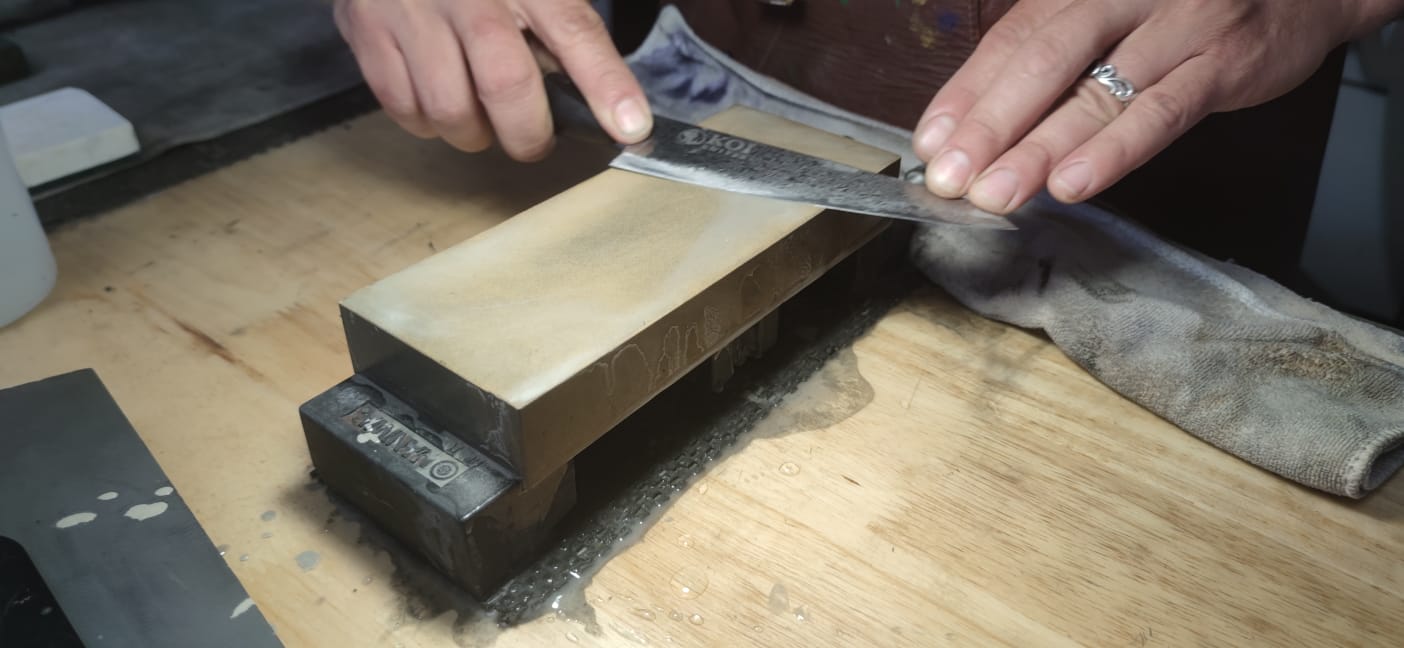Did you know that knives have been around for over 2 million years?
They've been important tools from ancient times to today's kitchens, and taking good care of them is really important to make them last.
Imagine getting a brand-new, shiny blade only to accidentally damage it within a week. Sadly, it happens more often than you might realise.
But don't worry, we're here to help you avoid those pitfalls.
Knowing the do's and don'ts of knife care can save you from costly mistakes and prevent unnecessary accidents.
So, let's explore the essentials of knife care together.
Mistake #1: Improper Cleaning and Dishwasher Misuse
Dishwashers might seem like a convenient way to clean your knives, but they can be a big no-no, especially for blades made of high-carbon steel.
These machines may expose your precious knives to harsh detergents, extreme temperatures, and vigorous water jets, leading to corrosion, dulling, and even rusting.
That's the last thing you want for your prized kitchen tools!
Importance of Hand Washing and Drying
Hand washing is the gold standard for keeping your knives in top-notch condition.
It's simple: a gentle scrub with mild soap and lukewarm water followed by thorough drying with a soft cloth.
This way, you can ensure your blades stay sharp and shiny for longer without any unwanted damage or wear.
Cleaning Techniques for Different Blade Materials
Different knives, different needs!
Regular hand washing is usually enough to keep stainless steel blades clean and pristine.
But for high-carbon steel or Damascus blades, a little extra care might be necessary.
Consider using a specialised cleaner or oil to maintain their beauty and functionality.
Just remember, a little care goes a long way in preserving the lifespan of your loyal knives.
Mistake #2: Misguided Choice of Cutting Surface
Glass chopping boards may appear stylish and contemporary, but they spell trouble for your knife.
Why?
Glass's unforgiving hardness accelerates blade dulling and can even cause chips.
Think of your knife as a car navigating rugged terrain where it's bound to wear down quicker on such unfriendly surfaces.
Wood, Bamboo, or Plastic Cutting Boards
Luckily, there are better options out there. Wood, bamboo, or plastic cutting boards are much gentler on your knife's edge.
They provide a softer surface that helps maintain sharpness for longer. The fibres of the material gently yield to the blade's edge, reducing the friction and stress on it.
It's like driving your car on a smooth highway—your knife will thank you for the smoother ride.
Choosing the Right Cutting Surface
When selecting a cutting board, factor in its maintenance and cleaning to ensure your knife's longevity.
Opt for materials that are gentle on your blade and easy to maintain. Wood and bamboo provide a classic aesthetic and are kind to your knife, while plastic offers durability and effortless cleaning.
Safeguarding your knife is making a smart investment in its long-term performance.
Mistake #3: Inadequate Storage Practices
Storing your knives in a drawer might seem convenient, but it's like sending them on a collision course.
Think about it: those sharp blades knocking against each other, potentially getting dulled or chipped.
Plus, rummaging around for the right knife can lead to accidental cuts. It's a recipe for disaster, really.
Proper Knife Storage Solutions
Besides tidying up your kitchen, think of your knives as prized possessions, each with its own purpose and potential.
Without the right storage, they're vulnerable to damage, dulling, and even accidents. But with the right setup, it's like giving them a cozy home to rest and recharge after a hard day's work.
Imagine a magnetic knife strip adorning your kitchen wall, showcasing your collection like a work of art. With each knife in its designated spot, you can easily grab the one you need without rummaging through cluttered drawers or risking a finger.
And let's not forget about knife blocks—those strong, reliable holders that keep your blades standing tall and ready for action. They protect your knives from harm and add a touch of elegance to your kitchen decor.
Finally, blade guards are like little shields that keep your knives safe and sound. So, ditch the drawer and embrace the wonderful world of proper knife storage. Your knives will thank you for it.
Mistake #4: Unsafe Blade Testing Habits
When you're excited about your new knife, it's tempting to run your finger along the blade to check its sharpness.
But doing so might get you a nasty cut.
Your fingertips are super sensitive, and even a slightly dull blade can cause trouble.
Plus, it's just not a reliable way to gauge sharpness.
Proper Sharpness Assessment Techniques
So, what should you do instead?
Well, it's all about using your eyes and ears. Look closely at the blade's edge to see if it's reflecting light evenly.
You'll notice some light bouncing off in random directions if it's dull. When you gently tap the blade with your fingernail, you should hear a crisp, clear sound—that's the sound of a sharp edge.
Also, grab a piece of paper, preferably something thin like printer paper or magazine paper.
Hold the paper steady with one hand and carefully bring the blade down onto the edge of the paper with a smooth, controlled motion. A sharp knife will effortlessly slice through the paper with clean, precise cuts, almost like a hot knife through butter.
However, if the blade struggles to cut through the paper or if it tears and rips instead of slicing cleanly, it's a sign that your knife could use some sharpening.
Burr and Its Significance
It's a tiny, almost invisible ridge of metal that forms along the edge of a blade when it's sharpened. Think of it like a microscopic sawtooth. When you run your finger along the blade, you might not feel the burr, but it's there. And if you're not careful, it can catch on your skin and cause a cut.
Mistake #5: Incorrect Sharpening Methods
The Myth of Stainless Steel Honing Rods
You might've heard that stainless steel honing rods are the way to go for keeping your knife sharp.
Well, hate to break it to you, but that's not entirely true.
While they can help align the blade's edge, they don't actually sharpen it. It's like straightening your hair without trimming the split ends—it might look neat for a bit, but it won't solve the real problem.
The Perils of Machine Sharpeners for Precision Blades like Koi Knives
Machine sharpeners might seem convenient, but they're not gentle on your precious blades, especially those fancy Koi Knives or knives with a precision edge.
Machines can strip away too much metal, leaving you with a blade that's seen better days.
Ceramic Honing Rods and Professional Sharpening Services
So, what's the solution?
Ceramic honing rods are gentle yet effective, perfect for maintaining your blade's sharpness between professional sharpenings.
And speaking of professionals, don't hesitate to take your knives to the professionals every once in a while.
They've got the skills and the right tools to give your blades the care they deserve.
Summary
First, cleaning your knife in the dishwasher is a big no-no, especially if it's got a fancy high-carbon steel blade. Glass chopping boards? No, they're not doing your knife any favours. Storing your knife in a crowded drawer is like asking for trouble. And please, please stop running your fingers along the blade! Finally, sharpening with the wrong tools can really mess up your knife.
Hand wash, pick the right cutting board, store it safely, be smart about testing sharpness, and use the correct sharpening tools.




